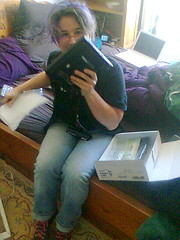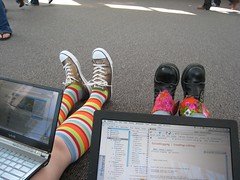I’m still halfway with a toe in poet-y land where everything is made of words and reality is very thin. It’s like swimming around in beautiful chaos! I love getting into that state of mind.
At the same time I’m messing about with techie things and it’s been a sort of cleanup week for me, as if it’s even more important for me to establish Order in the midst of my poety chaos.
I got fed up with my 8000+ emails in my Thunderbird inbox. I switched from using Pine about a year ago. And don’t get me started on how hard it was to get me even to the Pine level. I was very conservative and grumpy about it! Dammit, mm was good enough for me in 1989 and it was good enough for me in 1999! Anyway, my Thunderbird filters stopped working, and my inbox got goddamned huge. At times it has hit 20K. Finally, I gave up. I moved everything to a totally lame “2007 Inbox” folder. Voila! I’m at 0! As new flows in, I’ll construct new filters. And if I feel especially virtuous, I’ll go bulldozing through those 8000 old-inbox messages and put them away in logical places.
Search in Thunderbird still gives me hives. It starts searching the earliest emails first, and since I imported everything since 2003, holy hell it takes a long time to find the thing I filed away somewhere last month! Chug chug chug twiddle twiddle… sigh…
Still, it’s been pretty decent so far. I’m happy with it, though still wondering if I would be better off sending everything first to Gmail and then forwarding it on. Then I’d have it all two places without having to deal with IMAP.
My sister passed me a link today to some mozilla forum discussion about a bug with Firefox, Flash, and Ajax. Yeah I had KIND OF NOTICED. Ready to throw my computer out the window over here if it hangs one more time while I’m surfing around, hanging and chugging up my CPU without rhyme or reason. The links were all to PC/Ajax bug discussions, but here I am running FF with “Activity Monitor” up, because running top in a term window just makes the cpu usage problem worse, but with Activity Monitor I can sometimes kill Firefox before my whole machine crashes and I have to hard restart.
A few poking-around searches and I got to this repository of Firefox builds including ones for Intel Macs. So far I haven’t crashed today… huzzah. What will happen? Will it delight my heart? Will it bear all the weight I pile upon its back?
I’ve been using Desktop Manager (inspired by Skud). With this I can set up many different desktops and rotate between them, which is perfect! It’s rad! It’s not totally reliable but that doesn’t matter. I miss my old techie jobs where I would have 3 machines; a Mac, a PC, and an old Sun server. It felt like having a fabulous command center to swivel about and have all different junk set up on each computer. Plus on the Sun I’d have XWindow and 4 different desktops where I did all the real work. Anyway, now I have one small laptop, plus Desktop Manager. It’s nifty. At first I was mildly annoyed that I couldn’t get “move this window to Desktop 3” to work. Then I figured out I could just minimize it, go to 3 with a keystroke, and re open those windows with Quicksilver, which is relatively painless — I can train my hands to do it, like playing the piano. Mousing and trackpads suck because you can’t get that finger memory really working.
Mmmmm, Quicksilver. It haunts me. I am only scratching the surface of its beautifulness. It makes me so happy. It’s elegant! It feels like a powerful beast waiting to be tamed and taught tricks! So far I only really use it to switch and open apps. But, if I wanted to make some more nifty productivity stuff, Quicksilver is probably where I’d start. Danny babbled a bit to me about writing Applescripts to do various things. Applescript has never appealed to me. Maybe.
Meanwhile, at work yesterday Pete showed me YubNub so I’m in command line/ keystroke heaven. Now I can command-K up to the toolbar and I’ve got a bazillion useful shortcuts predefined.
You’d think that’s enough new stuff. But I have all these nagging projects. I spent some time at 7am this morning dicking around with me and Laura‘s Mediawiki install which has had annoying blanking and nonsense-insertion vandal attacks lately. As I looked around on the net I came across an article by WikiAngela that made great sense. I agree, it is better to leave a wiki open to anonymous edits! Then I came across Bad Behavior, a blacklist/whitelist application that I could certainly use on some blogs as well. Finally I ended up reading an incredibly useful article, Blocking Spam in Mediawiki. I did a bunch of it while Laura and I knitted our brows over permissions and group problems on the server. (Note: ConfirmEdit.php has a bug which breaks when it gets urls with a trailing backslash.) Oh man! Thank you for that excellent, brief, practical guide. Even if I cracked up hysterically laughing at your Orgasmosocialism page… OMG. Somehow “destroying the patriarchal institution of marriage and monogamy” was left off this dude’s list of the utopia which eliminates all social and political barriers to “the development of intimate relationships between consenting parties”.
Then I spent most of the rest of the day actually working. No really! It’s not just that my coworkers might read this! Except for when I went out for pie and bacon and the Bad Ass Mama’s Coffee Hour! I can prove it because finally this is up on SourceForge. I need to wrassle the ginormous release notes and bug fixes into a more news-like blog post and announcement for email lists. But it is nice to have it more or less out there for consumption. Yesterday I was melting down at the thought that I was stuck. But actually it was very very almost done, and things were fine. Why always with the last minute tearing out of my hair. I wish I hadn’t spazzed about it! At least not in front of people.
I leave you with this final, snarky, juicy thought as a reward for reading all the way to the end of this post. On a wonderful mailing list that I love dearly that shall not be named there was a long serious thread about this article on a nerd auction. The Washington State University LUG is auctioning themselves off at a Nerd Auction, to sorority girls, offering to fix their computers in exchange for a makeover. I cannot wait for the video. My god. I mean I am going to buy a plane ticket and quickly join the WSULUG. A lightning-smart hot chick in a pink sweater will buy me, and I will fix her computer. I will totally impress her with Quicksilver and Yubnub. Then, the (mutual) makeover, with a lot of giggling. Hey! Why not just sleep over in the sorority house? Geek slumber party! They’ll all end up with funny colored hair and will start wearing Leatherman tools on their belts, while I’ll come out of it all dishevelled, with lipstick all over my shoulders and a kick ass pedicure. Screw you nerds I am stealin all ur wimminz…
<
br />And then afterwards when all the ditzy sorority girls naturally reject the pale weedy glasses-taped-together nerd boys, I will be around the next day to comfort them…so I’d get the action from repressed, desperate nerds too. What a great setup!
“You can buy a nerd and he’ll fix your computer, help you with stats homework, or if you’re really adventurous, take you to dinner!”
My actual answer to that is unprintable and many-leveled and includes a snarling declaration of the actual meaning of Adventure.
No, seriously. The whole idea is kind of funny and yet pisses me off big time. I love the comment from this WSU mom of a geek daughter:
Do a search on world of warcraft and you will be loaded with girls who have no idea that WSU has great computer science department with a sense of bizarre humor.
Hell, if you had had a booth showing your online programs (assuming) for the stuff she does (which I don’t do…like Maya, etc.,etc., she might take an interest in her mother’s old school. Or maybe you are all Alliance and not Horde. Or are you all waiting for Halo 3. She lives on Newegg and is building her latest and greatest computer as we speak and would never ever join a sorority.
What a taunt! Hahaha!
Seriously again, the auction PR stunt plays up the very stereotypes they are trying to fight. Another comment points out,
Seriously, people, you wonder why you need this much press to get a woman to come within 10 feet of your sorry selves? This brings back every sexist or otherwise slimy incident I experienced studying engineering. . .
I have to agree, although I love ridiculous fun and can see that this LUG thought it was playing with stereotypes, not playing them up. I wish them success in that goal. And, presuming human decency from the bulk of them, I understand the lure of the spectacle and of publicity and of a joke. However, the impression I get is also that as a woman I am expected by their department’s culture to laugh and go along with degrading stereotypes of my gender.
But, I hope that the end result is that the CS department asks women why they don’t enter or stick with CS as a major, and listens to the answers, and acts on that. Or, they could go read the many studies which address exactly that question. How about this one by Ellen Spertus, Why Are There So Few Female Computer Scientists? . How about reading She’s Such a Geek, a book of fabulous essays by geeky women, in which nearly every essay explains the barriers and annoyances we face. Or this paper by Tracy Camp, The Incredible Shrinking Pipeline. There are a zillion more.
Maybe if they paint the Computer Science Dept. building pink? That might help?
I wonder what they do to encourage racial minorities to enroll… “Nerds” fix your computer, and you teach them to… what? What race and stereotype spring to your mind? Think that event would happen? No? Then why is this one okay?
Despite everything I have ever experienced and said about geek culture and gender, here is the key. I still expect geeks to be better than this. My techno utopia has got some basic feminism in it and so do a lot of other people’s.
Technorati Tags: academia, fantasy, fashion, funny, geeks, gender, software, techie tools



